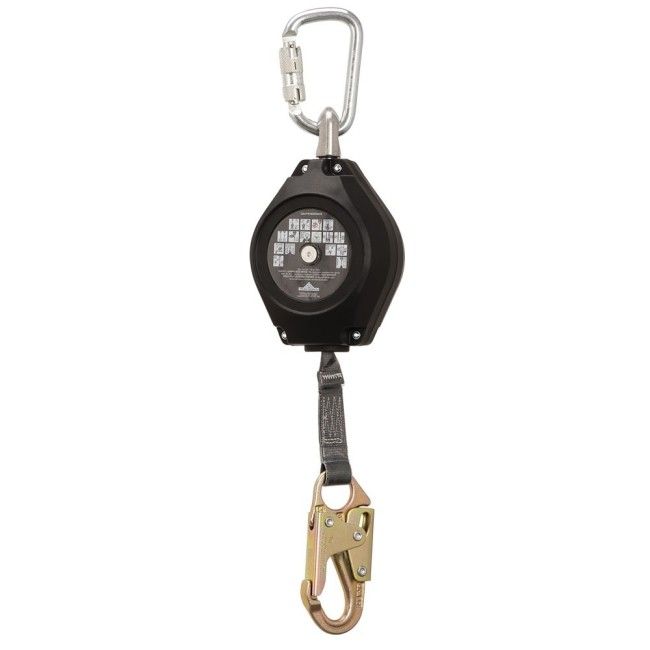





No returnable if used. For more information about our return policy, please refer to the Orders and Returns.
Peakwork's Self-Retracting Lifeline or Personal Fall Restrictor (SLR-LE) with internal energy absorber and a length of 18 feet. This self-retracting lifeline for downslope application (SLR-LE) has the unique feature of being Leading Edge (LE). This model features enhancements to protect workers from sharp edges also known as Leading Edge (LE) applications. This protection is subject to the conditions of use described in the user manual. The webbing is made of 0.8" wide x 0.07" thick Dyneema® (20 mm wide x 1.75 mm thick). Dyneema® is recognized as an excellent fiber for cut and shear resistance. The manufacturer recommends using this self-shrinking lifeline in temperatures ranging from -40° C to 50°C (-40°F to 122°F).
Peakwork product code: V845722018LE, model # SRL-80302-18LE.
This product complies with ANSI Z359.14-2014 Class B, and CSA Z259.2.2-2017.
This self-retracting lifeline has two carabiners, a swivel carabiner with a standard 7/8" (22.22 mm) opening and a semi-automatic (rotating ring) carabiner with a ¾" (19 mm) opening. The carabiners are self-locking and unlock with a double action.
This personal fall limiter with a vertical or horizontal anchor can support a worker weighing up to 310 lb (136 kg), including clothing, tools and equipment.
During a fall, the fall distance varies depending on the anchor arrangement. The maximum stopping distance is 19" (0.49 m) with a vertical anchor point and 76" (1.92 m) for a horizontal anchor. These values represent (DD) the deployment value of the connection device indicated in the free fall distance calculation diagram. Its braking mechanism combined with the energy absorber will limit the forces exerted on the falling worker. For a worker weighing a maximum of 310 lbs, the stopping forces will be 4.12 kN (928 lbf). Once the arrest mechanism is deployed, the lifeline overload indicator will appear. It is possible to have it repaired by the manufacturer, contact our customer service for a quote.
The carabiners (hooks) are made of steel and are capable of withstanding a force of 3600 lb (16 kN) without deforming.
The housing is made of impact-resistant plastic and corrosion resistant parts. Due to its weight, the housing is installed near the anchor point. The enclosure is approved for use in horizontal or vertical positions, hence the Class B certification. In addition, it is equipped with an integrated rotating swivel that prevents the strap from twisting. Its total weight is 5.80 lb (2.63 kg).
The self-retracting lifeline has a certification label on the housing.
Regarding the anchor point and free fall distance:
The anchor point should preferably be located above the level of the harness back loop and should be positioned vertically to the user. The worker should remain below the anchor point so as to remain within a perimeter of no more than a 30-degree angle.
It can also be used in a horizontal configuration, i.e. the anchor point can be lower than the back ring. To avoid a swaying effect causing injury, the range of lateral movement should be limited to within 59" (1.50 m) on either side of the centerline formed with the anchor point. The minimum setback required to install the anchor point shall be a minimum of 16" (40 cm) from the edge. In addition, if there are unprotected sharp edges, they shall be secured. The radius of the edge must be greater than or equal to 0.010 in (0.25 mm). This is regularly found on rolled steel profiles, wood beams or on rounded paneling.
It is important that the user be aware of the risks of a possible fall. Among other things, is there a sufficient distance free of obstacles below the worker? Are there emergency measures to recover quickly? Can the anchor point withstand a force of 5000 lb? For more information, consult the manufacturer's manual.


Inspection:
The worker is responsible for performing a routine inspection before each use. During this routine inspection, the worker should observe any signs of damage, wear, malfunction or breakage. You must replace your equipment at the first sign of failure.
In addition, this retractable should be inspected by a qualified person other than the worker. The required frequency of these inspections varies by manufacturers. Some prescribe every 90 days, other every 180 days, or even annually.
Keep in mind that the more difficult the work and environmental conditions, the more often your equipment will need to be inspected. Sylprotec offers an inspection service for lanyards and safety harnesses. For self-retracting lifelines, we offer this service through the manufacturer. Find out more by clicking on the Services tab, under the Sylprotec logo at the top of the page.
Suggestion:
To complete your fall protection you will find a range of harness and anchors. Some products are suggested under the "accessories" tab at the bottom of this page.
Other equipment frequently used with this Self Retractive Lanyard:
Safety glasses YA12E90801
Liberty TA14LR safety helmet and the essential TA14CS chin strap
EPTCONE28 Traffic Cones
Peakworks FPBAG storage bag
The FPL9903 Tool Strap
Data sheet
You might also like